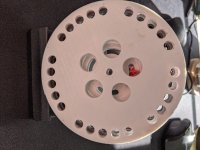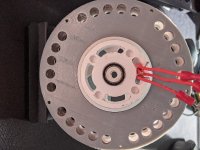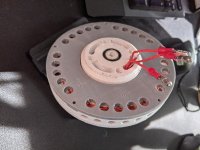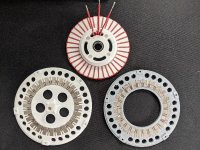HalbachHero
100 W
- Joined
- Apr 5, 2021
- Messages
- 228
Thecoco974 said:Basicaly in star you have two phases in series, the two phase voltages are added and give line voltage. Beeing 120° appart the sum isn't two time peak phase but Root(3) * Peak phase voltage. kv = Peak line-line voltage/RPM so going from star to Delta increase the kV by a factor of Root(3). Also in Delta when powering a phase there is a leakage current going through the two other phases not contributing to torque and causing inneficiencies.
So in most cases star is choosen with a number of turns giving the wanted speed range.
Switching to Delta only when high speed is needed has been done on this forum I think but wasn't giving good results if I recall.
If you have a good multimetre, probing Line to Line in AC mode could give good results if the frequency isn't outside the input frequency range, but the rectifier trick has allowed me measuring it at low frequency on crazy low kv generators.
Without back Iron is a good first test anyway, validating (or not) the simulation result.
Looking forward to it !
Thanks for this. that is helpful. I will still stay away from using it for now, but I will continue to leave all the wires accessible for if I ever do end up using it. My multimeter is good enough I think.... Its sort of an off brand, but seems to have many functions.
Rotors were all glued up. I smacked the stator into place, and put it together with magnets only




But unfortunately, this post ends in bad news. One thing that I noticed while putting the magnets into one rotor, was that it bent quite a bit. I assume from the strength of the magnets all pulling together. This really messed with the tolerances. It wouldn't even spin. At first I thought it was my epoxy issue, so I tried to force it to spin, which sort of worked. there was still a lot of friction. So I sprayed it with some Teflon lubricant, and hooked it up to an ESC. I got it to spin, but it pulled a ton of current and got hot in a second. When I removed half the rotor, I realized that it smoothed things out, but in doing so it revealed that not all of my wires were fully in the channels. Also, the amount of current that it pulled or something, pulled the coil ends out of their slot on the hub, which caused even more friction. I have a gear extractor, but I cannot fit it on with the stator in place. So I do not have a good way of removing the stator from the other side of the hub. Also, since I tried to clean up the stator after I had glued it to the hub, I think I ruined its ability to stay in place a bit. It seemed to move around rather freely.
Given all of this.... I have made some modifications to the stator hub and the rotor that was bending. I am still not quite sure why one rotor bent while the other didn't. They appear to be the same thickness, but perhaps different infill pattern or percentage? I'm not sure. I added 1mm to the rotor thickness to help with this. I have to imagine having an iron back on the magnets would help with this too. On the ring shaped rotor, I added a slight chamfer to one side of the inner diameter to help provide a bit more clearance for gooped up epoxy. I modified the Stator hub too to hold the wires better, and I put notches on 120 degrees apart to facilitate using the gear extractor to separate things If I need to in the future. I also modified the stator. I am going to try to go a bit extreme with the overhangs on the inner diameter in hopes that it will provide a flat surface of some kind to epoxy better to the hub. I also slightly moved the position of the wire channels a bit deeper to better hold them on top and bottom.
I think even with the design changes though, there are some concerns. I still do not think that the stator and hub have a solid enough connection. Also don't like that the wires stuck up out of the channels.
I keep talking about a jig, but I think that's what needs to be made to help push the wires into place after winding, and maybe something that could easily be clamped when epoxying the stator to the hub. But, also I am thinking it would make more sense to try to wind all three phases at once as the wires can overlap and more uniformly fall into place (I hope). So I am thinking of some kind of three sectioned spool that would each hold only enough for each phase that I could wrap around easily.
I feel so defeated by the tolerance issue, I should have seen that coming and not put it all together. I got too ambitious. However, I think I learned a lot, and I am ready to try again. I have already printed another rotor with the thicker backing, and the hub will be done momentarily. The ring shaped rotor and the rotor separator are re-usable, and I sanded a chamfer on the ring rotor. I also have an extra stator core that I could use to try playing with if I get too impatient.
Not sure I want to count this last one as mk4 given the lack of success, but there will be another motor soon!

